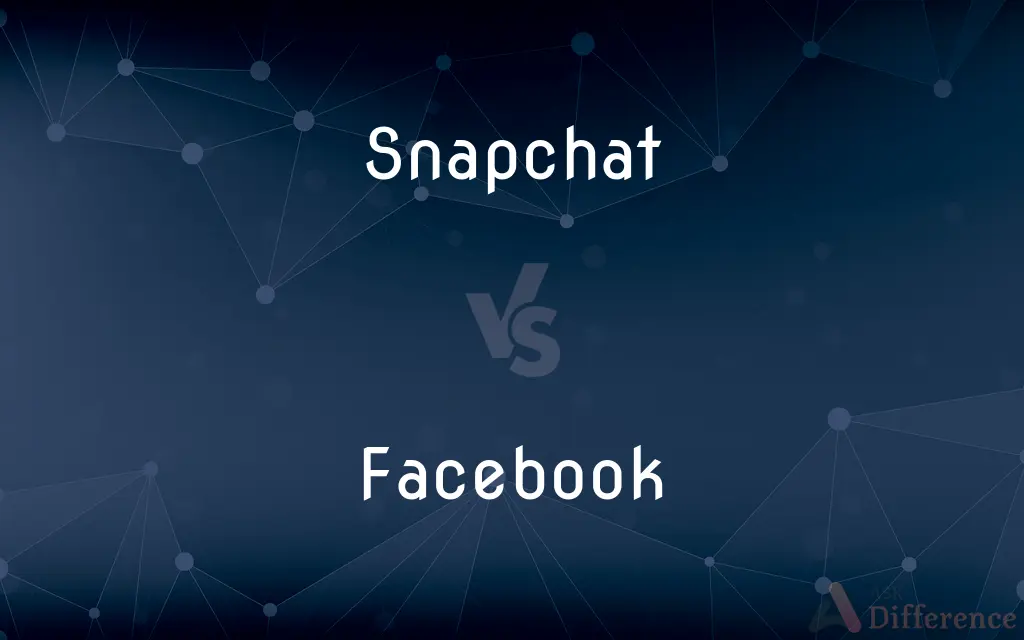Snapchat vs. Facebook — What's the Difference?
Edited by Tayyaba Rehman — By Maham Liaqat — Updated on May 7, 2024
Snapchat emphasizes temporary, multimedia-based messaging with its Stories and Snaps disappearing after viewing, whereas Facebook supports more permanent, text-based content sharing and a wider range of social interactions.

Difference Between Snapchat and Facebook
Table of Contents
ADVERTISEMENT
Key Differences
Snapchat's primary feature is its Stories and Snaps which are designed to disappear after they have been viewed or after 24 hours, creating a sense of urgency and spontaneity. On the other hand, Facebook focuses on creating a more permanent digital presence where posts and shared content remain visible unless actively deleted by the user.
Snapchat offers a range of augmented reality filters and lenses, enhancing user interactions through dynamic visual effects. Whereas Facebook provides a broader set of features including status updates, photo uploads, and extensive networking tools, catering to a more diverse audience.
Snapchat prioritizes user privacy with features like screenshot notifications and no permanent record of conversations. Facebook, however, has faced scrutiny over privacy concerns but offers more extensive privacy settings and user controls over who can see their content.
Advertising on Snapchat is heavily geared towards immersive, interactive ad formats that engage younger audiences. Facebook, on the other hand, utilizes a more traditional advertising model that includes targeted ads based on extensive user data, appealing to a wide range of businesses.
Comparison Chart
Content Lifespan
Messages and stories disappear
Content is permanent
ADVERTISEMENT
Privacy
High with disappearing messages and notification for screenshots
Extensive settings but concerns over data usage
Core Use
Multimedia messaging, fun and spontaneous interactions
Social networking, news sharing, business pages
Advertising
Interactive and immersive formats for younger audiences
Broad targeting options using detailed user data
Compare with Definitions
Snapchat
Multimedia messaging app known for ephemeral content.
She sent a Snapchat with her new puppy.
Utilizes targeted advertising.
The Facebook ads were customized based on her browsing history.
Snapchat
Advertisements are often interactive.
The Snapchat ad let users play a mini-game within the app.
Social media platform for networking and content sharing.
He shared the event details on Facebook.
Snapchat
Features augmented reality filters.
Using Snapchat, he transformed into a cartoon character.
Used by a diverse age group.
Her grandmother uses Facebook to stay in touch with family.
Snapchat
Privacy-centric with screenshot alerts.
Snapchat notified her when someone took a screenshot of her Snap.
Offers detailed privacy settings.
He adjusted his privacy settings on Facebook to restrict who can see his posts.
Snapchat
Snapchat is an American multimedia messaging app developed by Snap Inc., originally Snapchat Inc. One of the principal features of Snapchat is that pictures and messages are usually only available for a short time before they become inaccessible to their recipients.
Supports various content types like text, images, and videos.
She posted a video on Facebook from her concert.
Snapchat
(Internet) Snapchat
Facebook is an American online social media and social networking service owned by Facebook, Inc. Founded in 2004 by Mark Zuckerberg with fellow Harvard College students and roommates Eduardo Saverin, Andrew McCollum, Dustin Moskovitz, and Chris Hughes, its name comes from the face book directories often given to American university students.
A reference book or electronic directory made up of individuals’ photographs and names.
A college publication distributed at the start of the academic year by university administrations with the intention of helping students get to know each other better.
The shipment of facebooks will be distributed to the freshmen during orientation and move-in-week.
Alternative form of Facebook
Common Curiosities
What is the main purpose of Snapchat?
Snapchat is primarily used for sending temporary messages and multimedia that disappear after being viewed.
Which platform is better for privacy?
Snapchat generally offers better privacy due to the temporary nature of its content and privacy features like screenshot notifications.
How does Facebook handle user content differently than Snapchat?
Facebook retains user content indefinitely, allowing for ongoing interactions and a permanent online presence.
Can Snapchat be used by businesses for marketing?
Yes, businesses use Snapchat for interactive and visually engaging advertising aimed at younger audiences.
How does advertising on Facebook compare with Snapchat?
Facebook provides more traditional, targeted advertising options based on user data, while Snapchat offers immersive, engaging ad experiences.
Is Facebook suitable for younger users?
While younger users can use Facebook, it tends to be more popular with older demographics.
What types of content are most popular on Snapchat?
Ephemeral videos, photos, and AR experiences are most popular on Snapchat.
Does Facebook offer any temporary content features like Snapchat?
Facebook has integrated features similar to Snapchat's, such as Stories, which disappear after 24 hours.
How do Snapchat's augmented reality features work?
Snapchat's augmented reality features allow users to apply real-time effects and transformations to their faces and surroundings.
What are Facebook’s main features?
Facebook's main features include status updates, photo and video uploads, pages, groups, and extensive networking tools.
Share Your Discovery

Previous Comparison
Repent vs. Relent
Next Comparison
Tautology vs. OxymoronAuthor Spotlight
Written by
Maham LiaqatEdited by
Tayyaba RehmanTayyaba Rehman is a distinguished writer, currently serving as a primary contributor to askdifference.com. As a researcher in semantics and etymology, Tayyaba's passion for the complexity of languages and their distinctions has found a perfect home on the platform. Tayyaba delves into the intricacies of language, distinguishing between commonly confused words and phrases, thereby providing clarity for readers worldwide.












































